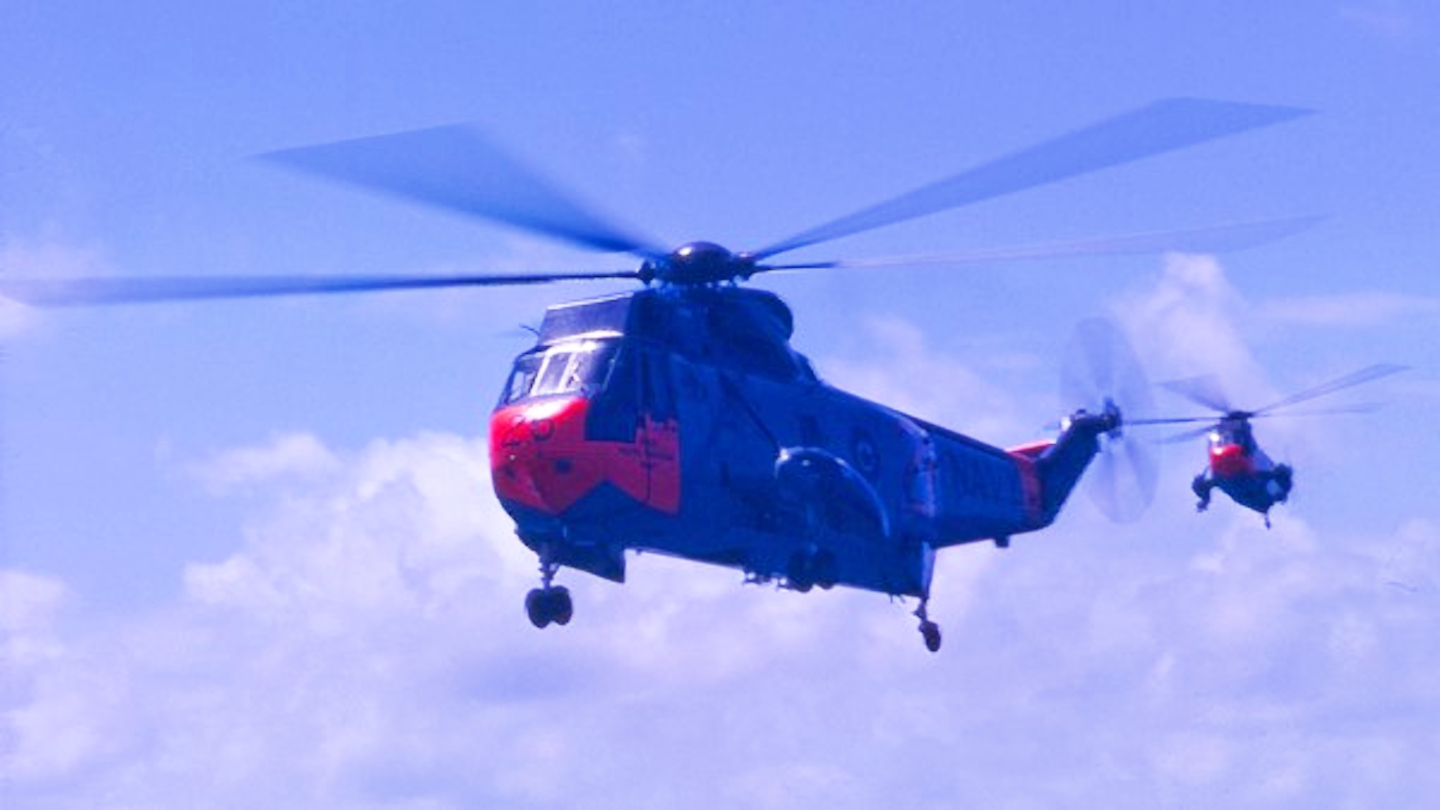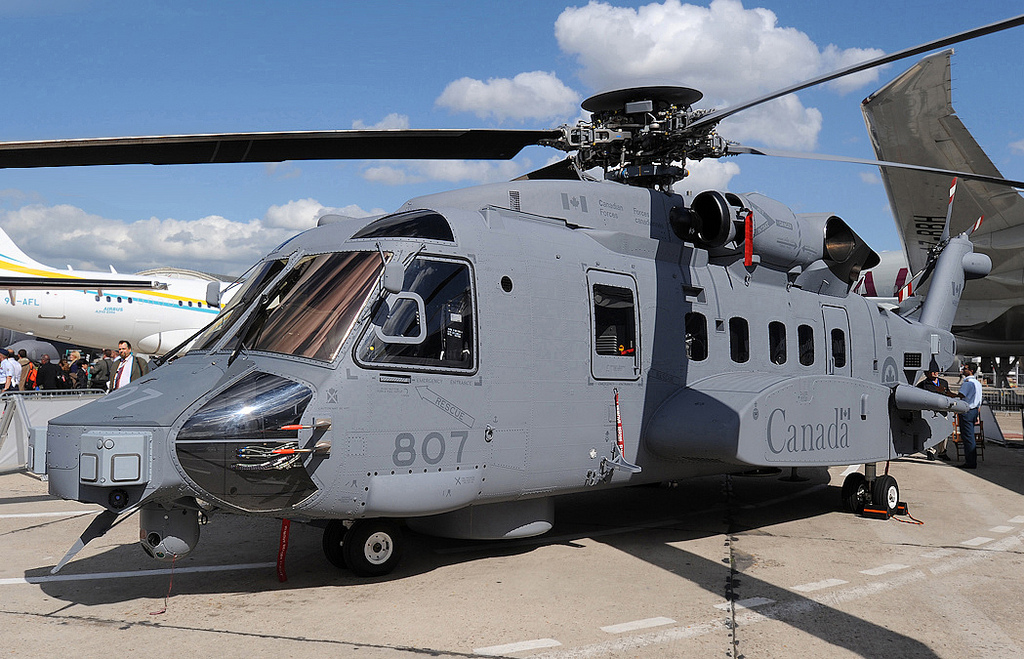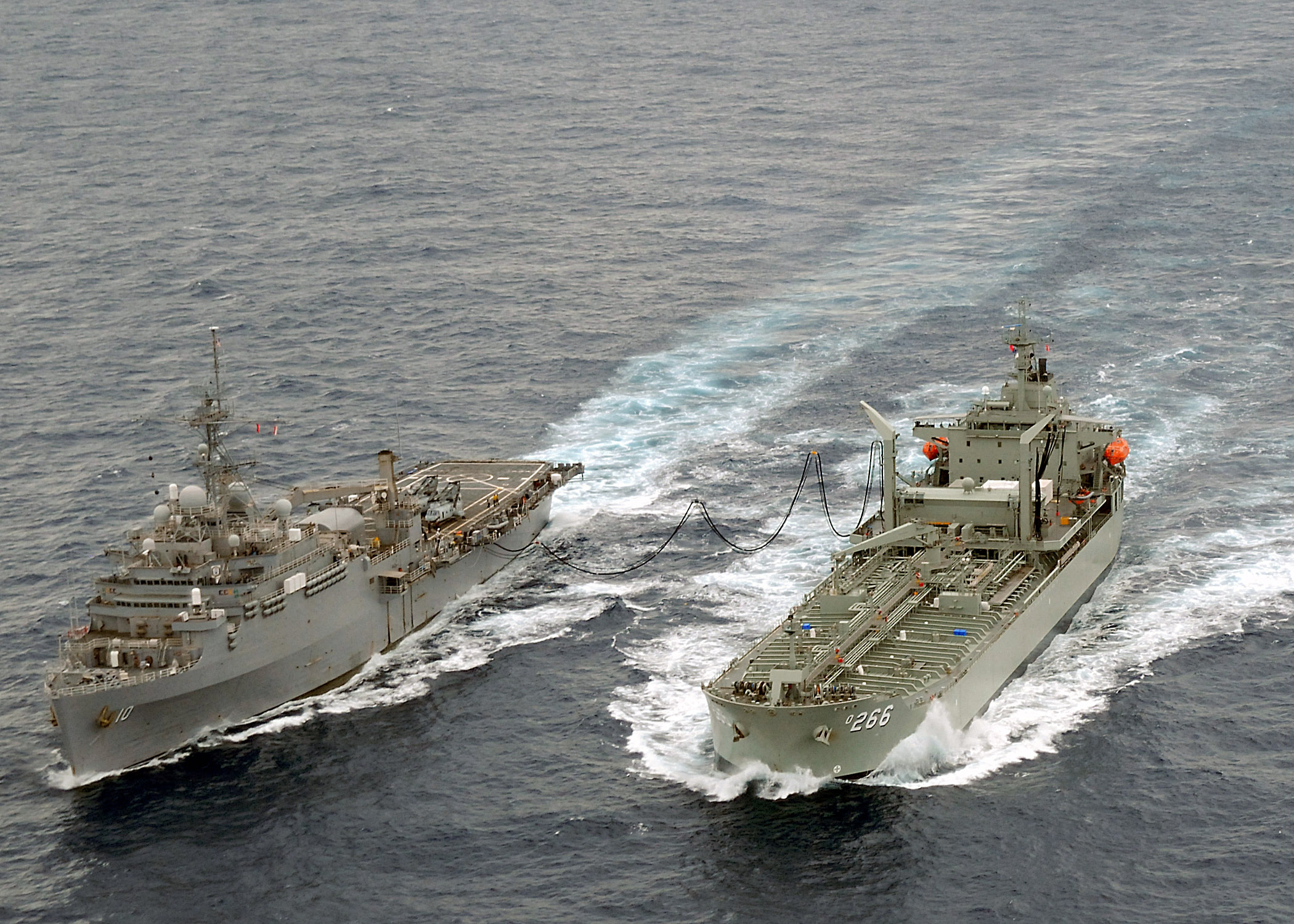|
Sikorsky CH-124 Sea King
The Sikorsky CH-124 Sea King (formerly CHSS-2) is a twin-engined anti-submarine warfare (ASW) helicopter designed for shipboard use by Canadian naval forces, based on the US Navy's SH-3 Sea King. Most CH-124s were assembled in Quebec by United Aircraft of Canada. The CH-124 served with the Royal Canadian Navy (RCN) and Canadian Armed Forces from 1963 to 2018. Design and development The advent of nuclear-powered submarines in the late 1950s let to the RCN assessing this new threat. While noisier than older submarines and thus detectable at longer ranges, nuclear submarines could also reach while submerged, faster than the RCN's new destroyer escort's top speed of . There were doubts that destroyers could effectively pursue and destroy such fast vessels, even when operating in pairs. During a 25 February 1959 Naval Board meeting, it was decided to counter the threat by operating helicopters from destroyers.Soward 1995, pp.169–171. The RCN examined the feasibility of operati ... [...More Info...] [...Related Items...] OR: [Wikipedia] [Google] [Baidu] |
Anti-submarine Warfare
Anti-submarine warfare (ASW, or in older form A/S) is a branch of underwater warfare that uses surface warships, aircraft, submarines, or other platforms, to find, track, and deter, damage, or destroy enemy submarines. Such operations are typically carried out to protect friendly shipping and coastal facilities from submarine attacks and to overcome blockades. Successful ASW operations typically involved a combination of sensor and weapon technologies, along with effective deployment strategies and sufficiently trained personnel. Typically, sophisticated sonar equipment is used for first detecting, then classifying, locating, and tracking a target submarine. Sensors are therefore a key element of ASW. Common weapons for attacking submarines include torpedoes and naval mines, which can both be launched from an array of air, surface, and underwater platforms. ASW capabilities are often considered of significant strategic importance, particularly following provocative instan ... [...More Info...] [...Related Items...] OR: [Wikipedia] [Google] [Baidu] |
Treasury Board
The Treasury Board of Canada (french: Conseil du Trésor du Canada) is the Cabinet committee of the Privy Council of Canada which oversees the spending and operation of the Government of Canada and is the principal employer of the core public service. The committee is supported by the Treasury Board of Canada Secretariat, its administrative branch and a department within the government itself. The committee is chaired by the president of the Treasury Board, currently Mona Fortier, who is also the minister responsible for the Treasury Board of Canada Secretariat. Role The Canadian Cabinet is arranged into several committees with varying responsibilities, but all other ones are informal structures and frequently change. Currently organized under the ''Financial Administration Act'', the Treasury Board is the only one created by law and is officially a committee of the Privy Council. Its role in government makes it far more powerful than most Cabinet committees as it is responsib ... [...More Info...] [...Related Items...] OR: [Wikipedia] [Google] [Baidu] |
CH-148 Cyclone
The Sikorsky CH-148 Cyclone is a twin-engine, multi-role shipboard helicopter developed by the Sikorsky Aircraft Corporation for the Canadian Armed Forces. A military variant of the Sikorsky S-92, the CH-148 is designed for shipboard operations and replaced the venerable CH-124 Sea King, which was in operation from 1963 to 2018. The search for a Sea King replacement began in the 1980s. The Cyclone is operational with the Royal Canadian Air Force (RCAF) as of 2018 and is to conduct anti-submarine warfare (ASW), surveillance, and search and rescue missions from Royal Canadian Navy warships. The helicopter is also to provide tactical transport for operations supporting national and international security efforts. In 2004, Canada awarded Sikorsky Aircraft a contract for 28 CH-148s with deliveries planned to start in 2009. Deliveries were repeatedly delayed due to development issues and difficulty fulfilling contract requirements; the first deliveries, involving six initial helicopt ... [...More Info...] [...Related Items...] OR: [Wikipedia] [Google] [Baidu] |
Canadian Sea King Replacement
From 1983 onwards, a replacement was sought for the aging Canadian Armed Forces Sikorsky CH-124 Sea King helicopters. Due to fiscal and political issues, the process was repeatedly delayed. In 1987, 35 EH101s were on order, but these were cancelled for budget reasons in 1993. The CH-148 Cyclone, a variant of the Sikorsky H-92 Superhawk, was selected in 2004, with deliveries delayed until 2015. The last CH-124s were retired in 2018. Background and EH101 In 1983, the Department of National Defence (DnD) began issuing contracts for the ''Sea King Replacement Project''; these were not intended to replace the CH-124, then reaching its 20th year with the Canadian Forces (CF), but instead was for develop new avionics for an unknown future replacement helicopter. By the mid-1980s, the CF started to regard the CH-124 as too small for anti-submarine warfare (ASW) due to the ever-increasing size and amount of ASW gear required. In 1985, the ''New Shipboard Aircraft Project'' (NSA) was sta ... [...More Info...] [...Related Items...] OR: [Wikipedia] [Google] [Baidu] |
Forward Looking Infrared
Forward-looking infrared (FLIR) cameras, typically used on military and civilian aircraft, use a thermographic camera that senses infrared radiation. The sensors installed in forward-looking infrared cameras, as well as those of other thermal imaging cameras, use detection of infrared radiation, typically emitted from a heat source (thermal radiation), to create an image assembled for video output. They can be used to help pilots and drivers steer their vehicles at night and in fog, or to detect warm objects against a cooler background. The wavelength of infrared that thermal imaging cameras detect is 3 to 12 μm and differs significantly from that of night vision, which operates in the visible light and near-infrared ranges (0.4 to 1.0 μm). Design Infrared light falls into two basic ranges: ''long-wave'' and ''medium-wave''. Long-wave infrared (LWIR) cameras, sometimes called "far-infrared", operate at 8 to 12 μm and can see heat sources, such as hot en ... [...More Info...] [...Related Items...] OR: [Wikipedia] [Google] [Baidu] |
TACCO
A Tactical Coordinator (Tacco, pronounced 'TACK-oh') is the aircrew member responsible for coordinating the activities of the part of the crew responsible for the tactical operation of the aircraft and its systems. The TACCO may, depending on the country, be the Mission Commander of the crew. Typically, TACCOs run the missions in Sikorsky CH-124 Sea King helicopters, Sikorsky CH-148 Cyclone helicopters, Lockheed P-3 Orion and Boeing P-8 Poseidon patrol aircraft and Lockheed S-3 Viking aircraft. They are specially trained for antisubmarine warfare Anti-submarine warfare (ASW, or in older form A/S) is a branch of underwater warfare that uses surface warships, aircraft, submarines, or other platforms, to find, track, and deter, damage, or destroy enemy submarines. Such operations are ty ... tactics, but also participate in other missions in which these aircraft are involved. TACCOs not only operate anti submarine warfare abilities but may also assist in controlling major o ... [...More Info...] [...Related Items...] OR: [Wikipedia] [Google] [Baidu] |
Replenishment Ship
A replenishment oiler or replenishment tanker is a naval auxiliary ship with fuel tanks and dry cargo holds which can supply both fuel and dry stores during underway replenishment (UNREP) at sea. Many countries have used replenishment oilers. The United States Navy's hull classification symbol for this type of ship was AOR. Replenishment oilers are slower and carry fewer dry stores than the U.S. Navy's modern fast combat support ships, which carry the classification AOE. History The development of the "oiler" paralleled the change from coal- to oil-fired boilers in warships. Prior to the adoption of oil fired machinery, navies could extend the range of their ships either by maintaining coaling stations or for warships to raft together with colliers and for coal to be manhandled aboard. Though arguments related to fuel security were made against such a change, the ease with which liquid fuel could be transferred led in part to its adoption by navies worldwide. One of the first ... [...More Info...] [...Related Items...] OR: [Wikipedia] [Google] [Baidu] |
Sikorsky CH-124
The Sikorsky CH-124 Sea King is a twin-engined anti-submarine warfare (ASW) helicopter designed for shipboard use by Canadian naval forces, based on the US Navy's SH-3. It served with the Royal Canadian Navy (RCN) and Canadian Armed Forces from 1963 to 2018. Design and development The advent of nuclear-powered submarines in the late 1950s let to the RCN assessing this new threat. While noisier than older submarines and thus detectable at longer ranges, nuclear submarines could also reach while submerged, faster than the RCN's new destroyer escort's top speed of . There were doubts that destroyers could effectively pursue and destroy such fast vessels, even when operating in pairs. During a 25 February 1959 Naval Board meeting, it was decided to counter the threat by operating helicopters from destroyers.Soward 1995, pp.169–171. The RCN examined the feasibility of operating ASW helicopters from small escorts, adding a temporary helicopter landing platform to the in mid-19 ... [...More Info...] [...Related Items...] OR: [Wikipedia] [Google] [Baidu] |
Canadian Forces Air Command
The Royal Canadian Air Force (RCAF; french: Aviation royale canadienne, ARC) is the air and space force of Canada. Its role is to "provide the Canadian Forces with relevant, responsive and effective airpower". The RCAF is one of three environmental commands within the unified Canadian Armed Forces. As of 2020, the Royal Canadian Air Force consists of 12,074 Regular Force and 1,969 Primary Reserve personnel, supported by 1,518 civilians, and operates 258 manned aircraft and nine unmanned aerial vehicles. Lieutenant-General Eric Kenny is the current commander of the Royal Canadian Air Force and chief of the Air Force Staff. The Royal Canadian Air Force is responsible for all aircraft operations of the Canadian Forces, enforcing the security of Canada's airspace and providing aircraft to support the missions of the Royal Canadian Navy and the Canadian Army. The RCAF is a partner with the United States Air Force in protecting continental airspace under the North American Aerospace D ... [...More Info...] [...Related Items...] OR: [Wikipedia] [Google] [Baidu] |
Canadian Army
The Canadian Army (french: Armée canadienne) is the command responsible for the operational readiness of the conventional ground forces of the Canadian Armed Forces. It maintains regular forces units at bases across Canada, and is also responsible for the Army Reserve, the largest component of the Primary Reserve. The Army is headed by the concurrently held Commander of the Canadian Army and Chief of the Army Staff, who is subordinate to the Chief of the Defence Staff. The Army is also supported by 3,000 civilian employees from the civil service. Formed in 1855, as the Active Militia, in response to the threat of the United States to the Province of Canada after the British Garrison left for the Crimean War. This Militia was later split into the Permanent Active Militia and the Non-Permanent Active Militia. Finally, in 1940, an Order in Council was issued to rename the active militias to the Canadian Army. On 1 April 1966, prior to the unification of the Canadian Armed For ... [...More Info...] [...Related Items...] OR: [Wikipedia] [Google] [Baidu] |
Sea State
In oceanography, sea state is the general condition of the free surface on a large body of water—with respect to wind waves and swell—at a certain location and moment. A sea state is characterized by statistics, including the wave height, period, and spectrum. The sea state varies with time, as the wind and swell conditions change. The sea state can be assessed either by an experienced observer (like a trained mariner) or by using instruments like weather buoys, wave radar or remote sensing satellites. In the case of buoy measurements, the statistics are determined for a time interval in which the sea state can be considered to be constant. This duration has to be much longer than the individual wave period, but shorter than the period in which the wind and swell conditions can be expected to vary significantly. Typically, records of one hundred to one thousand wave periods are used to determine the wave statistics. The large number of variables involved in creating and des ... [...More Info...] [...Related Items...] OR: [Wikipedia] [Google] [Baidu] |
Beartrap (hauldown Device)
A helicopter hauldown and rapid securing device (HHRSD) or beartrap enables helicopters to land on and depart from smaller ships in a wide range of weather conditions. Similar devices are referred to as RAST and TRIGON. The beartrap was developed in response to the difficulties encountered when attempting to land larger helicopters from smaller ships. Until the hazard was effectively addressed, it was impractical to conduct such operations, thus multiple navies looked into various methods of easing ship-based landings under adverse conditions. During the late 1950s, the Royal Canadian Navy refitted the frigate with an experimental flight deck with the prototype beartrap; it underwent successful testing with Sikorsky HO4S-3 and Sikorsky H-34 helicopters. A second series of trials onboard during the early to mid-1960s led to the beartrap being cleared for operational use with the Royal Canadian Navy during April 1967. The Sikorsky CH-124 Sea King was the first Canadian helicopter ... [...More Info...] [...Related Items...] OR: [Wikipedia] [Google] [Baidu] |








